China Brands, Marketing & Consumers
Chinese Fashion First: Consumer Nationalism and ‘China Chic’
Consumer sentiments on Western brands and made-in-China fashion are changing.
Published
3 years agoon
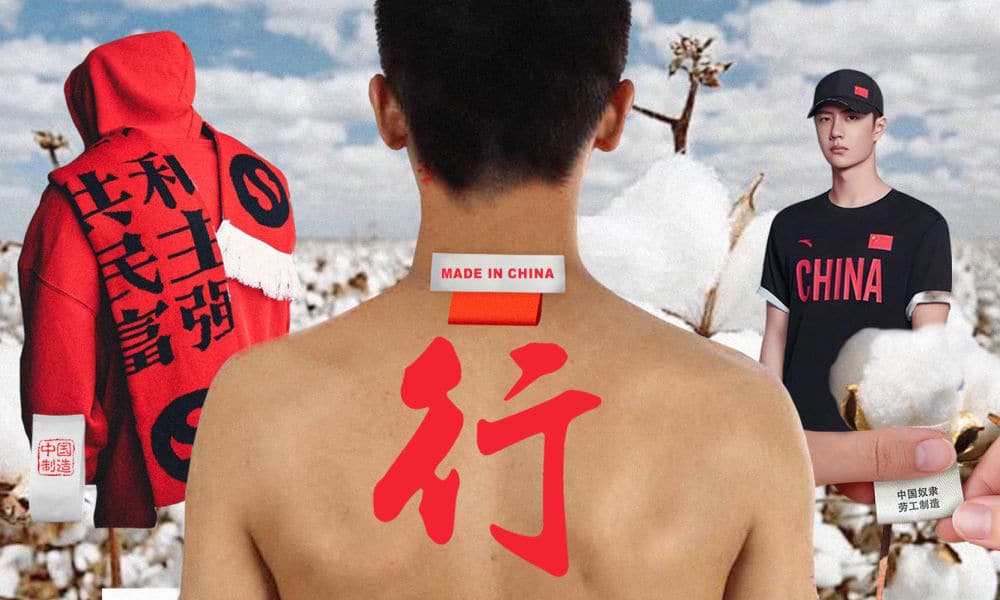
WHAT’S ON WEIBO ARCHIVE | PREMIUM CONTENT ARTICLE
At a time when Chinese media, celebrities, and consumers are condemning and boycotting Western brands, Chinese fashion and luxury brands are flourishing in a new era of “proudly made in China.”
This is the “WE…WEI…WHAT?” column by Manya Koetse, original publication in German by Goethe Institut China, see Goethe.de: WE…WEI…WHAT? Manya Koetse erklärt das chinesische Internet.
“The first thing Chinese fashion magazines should do is support the Chinese fashion industry, Chinese domestic brands, and Chinese designers!” In a video that went viral on social media, Hung Huang (洪晃), the famous American-Chinese television host and publisher of fashion magazine iLook, called out for a healthy development of China’s fashion industry that does not rely on Western brands to continue growing.
Hung Huang’s remarks were made in late March of 2021, around the time when a social media storm broke out in China over the Better Cotton Initiative (BCI) and its brand members – including H&M, Nike, and Adidas – for no longer sourcing cotton from China’s Xinjiang region. This boycott generated a huge backlash in mainland China. The online anger was mainly directed at H&M, since the Swedish retailer is a top member of the BCI and had previously released a statement on its site in which the company said it was “deeply concerned” over reports of alleged forced labor in the production of cotton in Xinjiang.
The news developments were followed by a wave of social media boycott campaigns and Chinese brand ambassadors cutting ties with international brands. It also ignited a social media movement in support of domestic brands, ‘made in China,’ and Xinjiang as China’s largest cotton-growing area.
The hashtag “I support Xinjiang cotton” (#我支持新疆棉花#) received a staggering 7.9 billion views on Weibo within a few weeks time. Simultaneously, a rising confidence in national brands became increasingly visible on social media, where the calls for supporting domestic brands are growing louder.
A recent survey by state media outlet Global Times suggests that most Chinese consumers believe that Western brands could be replaced by Chinese ones. The article claims that 75 percent of its survey respondents agree that “national products could fully or partially replace Western products.”
Proudly Made in China
Recent years have not just seen a rise in Chinese fashion brands, but also the emergence of a fashion scene where traditional Chinese elements play a major role. The Hanfu movement, for example, seeks to revitalize the wearing of Han Chinese ethnic clothing. But beyond that, brands are also weaving more Chinese themes into everyday fashion items such as sneakers and t-shirts.
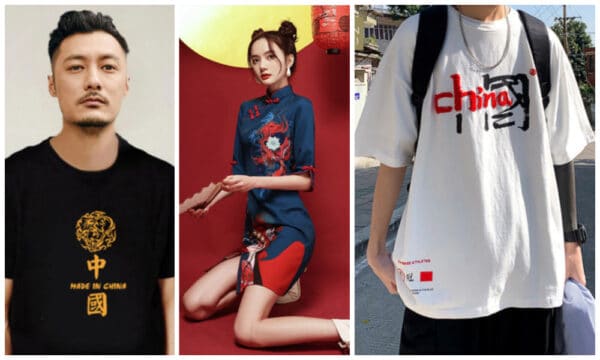
China themed fashion on e-commerce platform Taobao.
The rise in popularity of Chinese fashion brands and styles was dubbed the “China Chic” trend by CGTN in 2020. “China Chic” is a translation of “guócháo” (国潮), which literally means “national tide,” referring to the rise of domestic brands, with their designs often incorporating culturally Chinese elements into the latest trends. In 2021, for the first time ever, the Spring Festival Gala (Chinese state media’s biggest live televised event) also included a fashion show to show the beauty of Chinese costumes to “demonstrate cultural confidence.”
With celebrity endorsements being one of the most important strategies for social media marketing, Chinese celebrities play a crucial role in this trend as guócháo ambassadors. Chinese actor and singer Xiao Zhan (肖战) was praised on social media for becoming the new brand ambassador of the Chinese sportswear brand Lining. When celebrity Wang Yibo became the spokesperson for the domestic brand Anta Sports, one Weibo hashtag page on the topic received over one billion views (#王一博代言安踏#) in late April of 2021. The promotional poster featuring Wang Yibo shows him wearing a t-shirt with “China” on it, including the national flag – profiling Anta as a nation-loving brand.
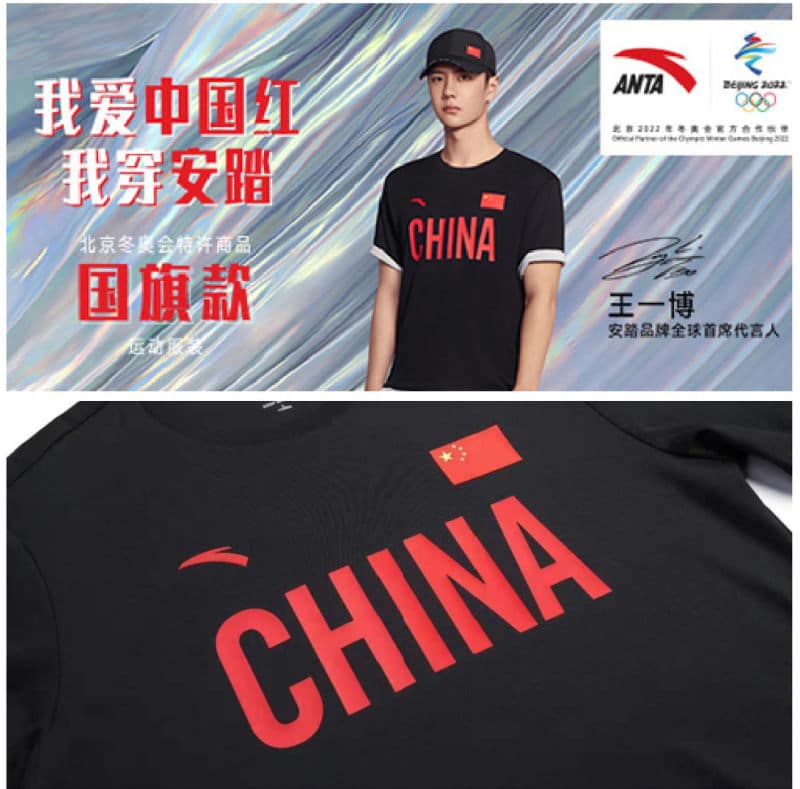
The rising popularity of ‘made in China’ fashion is noteworthy in a consumer culture where Western brands are often viewed as being of higher quality than domestically produced fashion. The very fact that these foreign brands succeeded in gaining access to China’s market is, in the eyes of many consumers, a reason to believe they must be of higher quality.[1] Those sentiments now seem to be shifting.
A recent Chinese short documentary produced by Tmall titled “Proudly Made in China” (爆款中国) discusses how Western brands have dominated the Chinese fashion and luxury market for years, making it more difficult for Chinese brands to become big players in their own field.
“Why are Chinese brands not as highly accepted by Chinese consumers?”, asks Li Jiaqi (李佳琦), an influencer and new brand recruiter for Tmall who is featured in the short film: “Why do Chinese consumers seem to have a preconceived and biased view that Chinese products are of poor quality?”
In the short film, Li explains that Chinese consumers have since long had worries about buying Chinese brands, and that one slight problem with a product will automatically negatively reflect on the entire brand.
Existing consumer preferences for Western brands have even created the idea that Chinese brands should register abroad and pose as a foreign brand to enlarge their chances to succeed in the Chinese market.
China’s flourishing live-streaming market and domestic e-commerce platforms have provided new opportunities for Chinese brands to shine once their products gain consumer recognition. Especially younger consumers, those born after 1995 or 2000, show more confidence in Chinese brands than the generations before them.
In the “Proudly Made in China” film, this growing trust in domestic brands among Chinese younger generations is linked to a striking confidence and pride in China, its national identity, and its culture. On Weibo, some commenters replied: “This is the era of domestic brands!”
Western Brand Controversies
Although the influence of national pride on China’s young consumers might already have been strong before, there are also changing dynamics in the relation between Chinese consumers and Western brands which seem to have boosted the ‘guócháo’ and domestic brand trend; Chinese brands have been cast in a more positive light over the past few years due to the controversies involving Western brands.
In 2018, Italian fashion house Dolce & Gabbana (D&G) faced consumer outrage in China for publishing a culturally insensitive advertising campaign that showed a Chinese model clumsily using chopsticks to eat Italian dishes such as pizza, cannoli, and spaghetti. The campaign, which was titled “D&G Loves China,” completely backfired with many finding it racist and sexist and vowing to boycott the brand. The controversy became so big that a big D&G fashion show in Shanghai was canceled and the company saw a slump in its business on the mainland.

Still from the promotional D&G video that was deemed racist in China, causing major controversy in 2018 (whatsonweibo).
In 2019, many different international fashion brands, including Versace, Coach, Calvin Klein, Givenchy, and ASICS, were condemned by Chinese netizens for listing Hong Kong, Macau, and Taiwan as separate countries or regions – not part of China – on their official websites or brand T-shirts. Chinese celebrities cut their collaborations with many of these brands.
When in 2020 the aforementioned Better Cotton Initiative (BCI) announced that it was ceasing all operations in northwest China’s Xinjiang Uygur Autonomous Region amid accusations of “forced labor” there, backlash in China further grew against the organization and the brands affiliated to it. As reported by CGTN, BCI has recently removed its statement on Xinjiang cotton from its website (allegedly this was related to a cyber attack), but the discussions on the position of Western brands in China continue, with both state media and netizens sending out the message that “foreign companies that slander China” are not welcome in the country.
The Future of Fashion Brands in China
“Boycott Nike? Support domestic brands? What are we supposed to do now?” It is a question posed by the Chinese ‘Sneakersbar’ vlogger Fang (@鞋吧Sneakersbar), a sportswear-focused self-media account with over 3,5 million followers on Weibo. The question resonates with many consumers, who are caught between politics, patriotism, and personal preferences for certain brands.
In their latest video, Sneakersbar makes up the balance on where Western brands, especially those affiliated with BCI, stand in the Chinese market today. On the one hand, Fang argues, many foreign brands, including Adidas, Nike, H&M, Uniqlo, and others, have already become part of China’s commercial fashion landscape and many consumers love these brands and their products. On the other hand, these foreign brands are also making political choices that Chinese consumers cannot ignore. But does this mean they should be boycotted forever? Does it mean that you should look down on others buying these products?
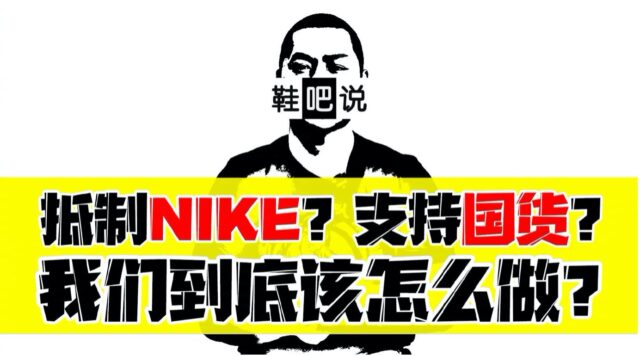
The video by popular weibo account Sneakersbar: “Boycott Nike? Support Domestic Brands? What are we supposed to do?”
The answer is that consumers should stay rational in their choices, Fang argues. This means that choosing Chinese brands out of a form of “rational patriotism” is fine, but people should not attack others merely because they wear foreign brands or work in their shops. The same goes for those consumers who only want to buy foreign brands just because they are foreign; they could also consider Chinese products to support domestic brands – especially those brands which refrain from copying foreign ones and have developed their own unique designs and styles.
Many commenters on Weibo support Fang’s message of “reasonable patriotism without blind worship” (“理性爱国,也不盲目崇拜”), supporting the idea that Western and Chinese brands can co-exist and that they can be competitors in a market where Chinese fashion labels are getting more room to grow.
“Nationalism and patriotism offer opportunities for Chinese brands,” one Weibo user writes: “China Chic and China fashion trends are putting more pressure on foreign brands. Because of the speedy rise of Chinese domestic brands, which are producing high-quality products and are applying smart marketing methods, more and more patriotic young people are buying their products.”
It is clear that many consumers in China support domestic brands and hope that Chinese fashion can flourish within its own market. But there are also those voices stressing the importance of consumers’ freedom to buy the brands that suit them, wherever they are from and regardless of politics. One person commented: “Western or Chinese brand, I just want to wear the shoes that are most comfortable for me to walk in.”
By Manya Koetse
Follow @whatsonweibo
[1] Tian, Kelly and Lily Dong. 2011. Consumer-Citizens of China: The Role of Foreign Brands in the Imagined Future of China. London & New York: Routledge. Page 7.
This text was written for Goethe-Institut China under a CC-BY-NC-ND-4.0-DE license (Creative Commons) as part of a monthly column in collaboration with What’s On Weibo.
Spotted a mistake or want to add something? Please let us know in comments below or email us. First-time commenters, please be patient – we will have to manually approve your comment before it appears.
Manya Koetse is the founder and editor-in-chief of whatsonweibo.com. She is a writer, public speaker, and researcher (Sinologist, MPhil) on social trends, digital developments, and new media in an ever-changing China, with a focus on Chinese society, pop culture, and gender issues. She shares her love for hotpot on hotpotambassador.com. Contact at manya@whatsonweibo.com, or follow on Twitter.

Also Read
China Books & Literature
Why Chinese Publishers Are Boycotting the 618 Shopping Festival
Bookworms love to get a good deal on books, but when the deals are too good, it can actually harm the publishing industry.
Published
2 months agoon
June 8, 2024By
Ruixin Zhang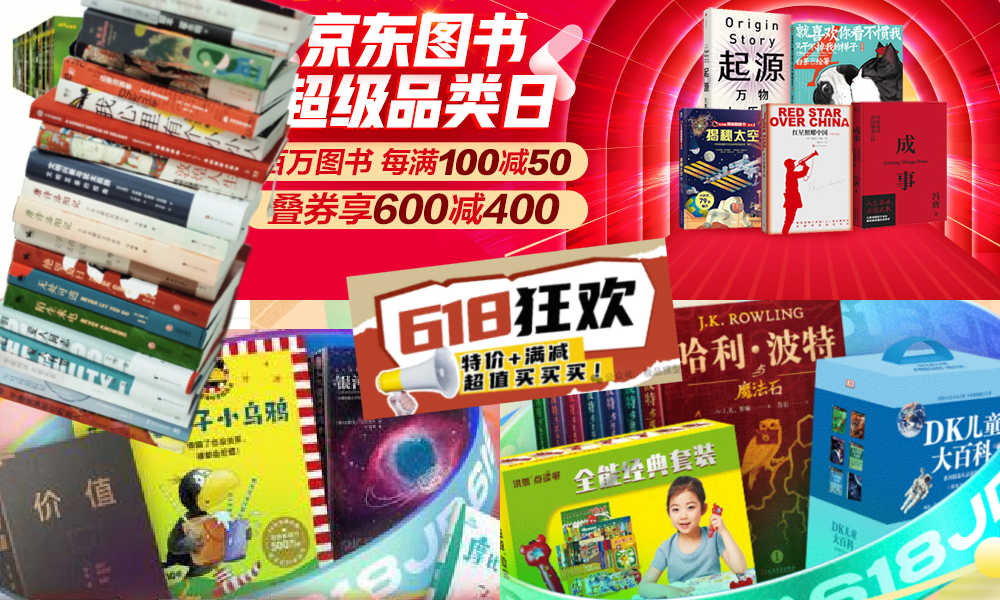
JD.com’s 618 shopping festival is driving down book prices to such an extent that it has prompted a boycott by Chinese publishers, who are concerned about the financial sustainability of their industry.
When June begins, promotional campaigns for China’s 618 Online Shopping Festival suddenly appear everywhere—it’s hard to ignore.
The 618 Festival is a product of China’s booming e-commerce culture. Taking place annually on June 18th, it is China’s largest mid-year shopping carnival. While Alibaba’s “Singles’ Day” shopping festival has been taking place on November 11th since 2009, the 618 Festival was launched by another Chinese e-commerce giant, JD.com (京东), to celebrate the company’s anniversary, boost its sales, and increase its brand value.
By now, other e-commerce platforms such as Taobao and Pinduoduo have joined the 618 Festival, and it has turned into another major nationwide shopping spree event.
For many book lovers in China, 618 has become the perfect opportunity to stock up on books. In previous years, e-commerce platforms like JD.com and Dangdang (当当) would roll out tempting offers during the festival, such as “300 RMB ($41) off for every 500 RMB ($69) spent” or “50 RMB ($7) off for every 100 RMB ($13.8) spent.”
Starting in May, about a month before 618, the largest bookworm community group on the Douban platform, nicknamed “Buying Like Landsliding, Reading Like Silk Spinning” (买书如山倒,看书如抽丝), would start buzzing with activity, discussing book sales, comparing shopping lists, or sharing views about different issues.

Social media users share lists of which books to buy during the 618 shopping festivities.
This year, however, the mood within the group was different. Many members posted that before the 618 season began, books from various publishers were suddenly taken down from e-commerce platforms, disappearing from their online shopping carts. This unusual occurrence sparked discussions among book lovers, with speculations arising about a potential conflict between Chinese publishers and e-commerce platforms.
A joint statement posted in May provided clarity. According to Chinese media outlet The Paper (@澎湃新闻), eight publishers in Beijing and the Shanghai Publishing and Distribution Association, which represent 46 publishing units in Shanghai, issued a statement indicating they refuse to participate in this year’s 618 promotional campaign as proposed by JD.com.
The collective industry boycott has a clear motivation: during JD’s 618 promotional campaign, which offers all books at steep discounts (e.g., 60-70% off) for eight days, publishers lose money on each book sold. Meanwhile, JD.com continues to profit by forcing publishers to sell books at significantly reduced prices (e.g., 80% off). For many publishers, it is simply not sustainable to sell books at 20% of the original price.
One person who has openly spoken out against JD.com’s practices is Shen Haobo (沈浩波), founder and CEO of Chinese book publisher Motie Group (磨铁集团). Shen shared a post on WeChat Moments on May 31st, stating that Motie has completely stopped shipping to JD.com as it opposes the company’s low-price promotions. Shen said it felt like JD.com is “repeatedly rubbing our faces into the ground.”
Nevertheless, many netizens expressed confusion over the situation. Under the hashtag topic “Multiple Publishers Are Boycotting the 618 Book Promotions” (#多家出版社抵制618图书大促#), people complained about the relatively high cost of physical books.
With a single legitimate copy often costing 50-60 RMB ($7-$8.3), and children’s books often costing much more, many Chinese readers can only afford to buy books during big sales. They question the justification for these rising prices, as books used to be much more affordable.
Book blogger TaoLangGe (@陶朗歌) argues that for ordinary readers in China, the removal of discounted books is not good news. As consumers, most people are not concerned with the “life and death of the publishing industry” and naturally prefer cheaper books.
However, industry insiders argue that a “price war” on books may not truly benefit buyers in the end, as it is actually driving up the prices as a forced response to the frequent discount promotions by e-commerce platforms.
China News (@中国新闻网) interviewed publisher San Shi (三石), who noted that people’s expectations of book prices can be easily influenced by promotional activities, leading to a subconscious belief that purchasing books at such low prices is normal. Publishers, therefore, feel compelled to reduce costs and adopt price competition to attract buyers. However, the space for cost reduction in paper and printing is limited.
Eventually, this pressure could affect the quality and layout of books, including their binding, design, and editing. In the long run, if a vicious cycle develops, it would be detrimental to the production and publication of high-quality books, ultimately disappointing book lovers who will struggle to find the books they want, in the format they prefer.
This debate temporarily resolved with JD.com’s compromise. According to The Paper, JD.com has started to abandon its previous strategy of offering extreme discounts across all book categories. Publishers now have a certain degree of autonomy, able to decide the types of books and discount rates for platform promotions.
While most previously delisted books have returned for sale, JD.com’s silence on their official social media channels leaves people worried about the future of China’s publishing industry in an era dominated by e-commerce platforms, especially at a time when online shops and livestreamers keep competing over who has the best book deals, hyping up promotional campaigns like ‘9.9 RMB ($1.4) per book with free shipping’ to ‘1 RMB ($0.15) books.’
This year’s developments surrounding the publishing industry and 618 has led to some discussions that have created more awareness among Chinese consumers about the true price of books. “I was planning to bulk buy books this year,” one commenter wrote: “But then I looked at my bookshelf and saw that some of last year’s books haven’t even been unwrapped yet.”
Another commenter wrote: “Although I’m just an ordinary reader, I still feel very sad about this situation. It’s reasonable to say that lower prices are good for readers, but what I see is an unfavorable outlook for publishers and the book market. If this continues, no one will want to work in this industry, and for readers who do not like e-books and only prefer physical books, this is definitely not a good thing at all!”
By Ruixin Zhang, edited with further input by Manya Koetse
Independently reporting China trends for over a decade. Like what we do? Support us and get the story behind the hashtag by subscribing:
Spotted a mistake or want to add something? Please let us know in comments below or email us. First-time commenters, please be patient – we will have to manually approve your comment before it appears.
©2024 Whatsonweibo. All rights reserved. Do not reproduce our content without permission – you can contact us at info@whatsonweibo.com.
China Brands, Marketing & Consumers
Chinese Sun Protection Fashion: Move over Facekini, Here’s the Peek-a-Boo Polo
From facekini to no-face hoodie: China’s anti-tan fashion continues to evolve.
Published
2 months agoon
June 6, 2024
It has been ten years since the Chinese “facekini”—a head garment worn by Chinese ‘aunties’ at the beach or swimming pool to prevent sunburn—went international.
Although the facekini’s debut in French fashion magazines did not lead to an international craze, it did turn the term “facekini” (脸基尼), coined in 2012, into an internationally recognized word.
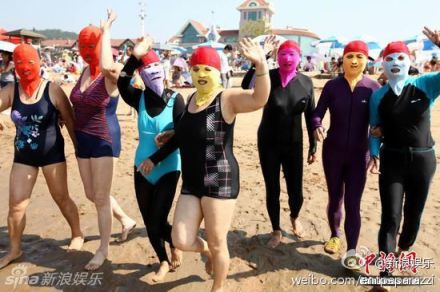
The facekini went viral in 2014.
In recent years, China has seen a rise in anti-tan, sun-protection garments. More than just preventing sunburn, these garments aim to prevent any tanning at all, helping Chinese women—and some men—maintain as pale a complexion as possible, as fair skin is deemed aesthetically ideal.
As temperatures are soaring across China, online fashion stores on Taobao and other platforms are offering all kinds of fashion solutions to prevent the skin, mainly the face, from being exposed to the sun.

One of these solutions is the reversed no-face sun protection hoodie, or the ‘peek-a-boo polo,’ a dress shirt with a reverse hoodie featuring eye holes and a zipper for the mouth area.

This sun-protective garment is available in various sizes and models, with some inspired by or made by the Japanese NOTHOMME brand. These garments can be worn in two ways—hoodie front or hoodie back. Prices range from 100 to 280 yuan ($13-$38) per shirt/jacket.

The no-face hoodie sun protection shirt is sold in various colors and variations on Chinese e-commerce sites.
Some shops on Taobao joke about the extreme sun-protective fashion, writing: “During the day, you don’t know which one is your wife. At night they’ll return to normal and you’ll see it’s your wife.”

On Xiaohongshu, fashion commenters note how Chinese sun protective clothing has become more extreme over the past few years, with “sunburn protection warriors” (防晒战士) thinking of all kinds of solutions to avoid a tan.

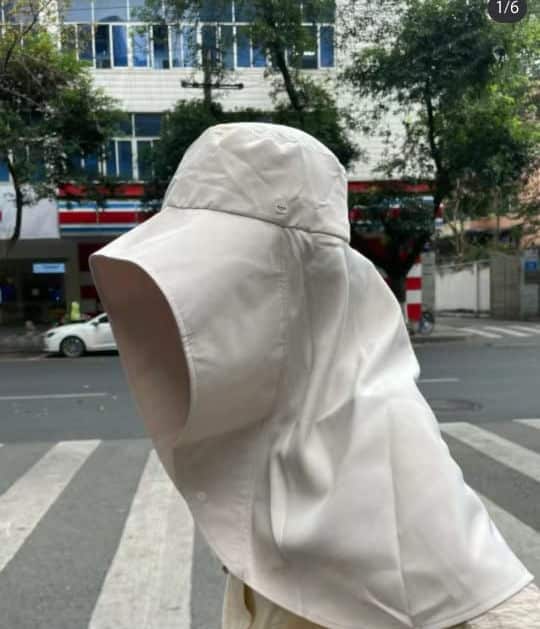


Although there are many jokes surrounding China’s “sun protection warriors,” some people believe they are taking it too far, even comparing them to Muslim women dressed in burqas.
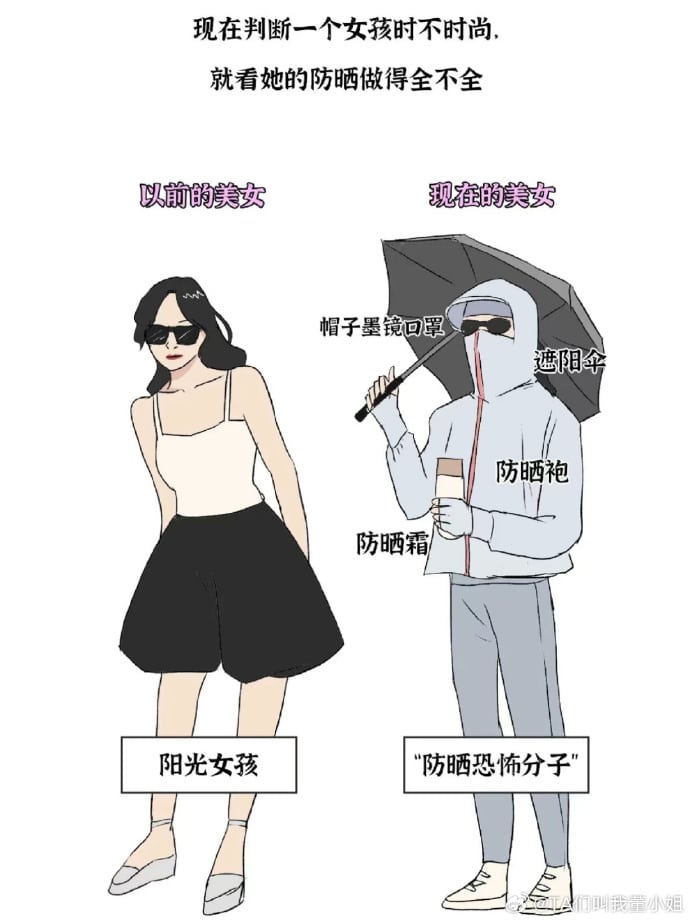
Image shared on Weibo by @TA们叫我董小姐, comparing pretty girls before (left) and nowadays (right), also labeled “sunscreen terrorists.”
Some Xiaohongshu influencers argue that instead of wrapping themselves up like mummies, people should pay more attention to the UV index, suggesting that applying sunscreen and using a parasol or hat usually offers enough protection.
By Manya Koetse, with contributions by Miranda Barnes
Spotted a mistake or want to add something? Please let us know in comments below or email us. First-time commenters, please be patient – we will have to manually approve your comment before it appears.
©2024 Whatsonweibo. All rights reserved. Do not reproduce our content without permission – you can contact us at info@whatsonweibo.com.
Subscribe

Weibo Watch: The Future is Here

“Bye Bye Biden”: Biden’s Many Nicknames in Chinese

Enjoying the ‘Sea’ in Beijing’s Ditan Park

A Triumph for “Comrade Trump”: Chinese Social Media Reactions to Trump Rally Shooting

Weibo Watch: Get Up, Stand Up

The Tragic Story of “Fat Cat”: How a Chinese Gamer’s Suicide Went Viral

“Old Bull Eating Young Grass”: 86-Year-Old Chinese Painter Fan Zeng Marries 36-Year-Old Xu Meng

A Brew of Controversy: Lu Xun and LELECHA’s ‘Smoky’ Oolong Tea

Singing Competition or Patriotic Fight? Hunan TV’s ‘Singer 2024’ Stirs Nationalistic Sentiments

Zara Dress Goes Viral in China for Resemblance to Haidilao Apron

Weibo Watch: The Battle for the Bottom Bed

About the “AI Chatbot Based on Xi Jinping” Story

China’s Intensified Social Media Propaganda: “Taiwan Must Return to Motherland”

Weibo Watch: Telling China’s Stories Wrong

Saying Goodbye to “Uncle Wang”: Wang Wenbin Becomes Chinese Ambassador to Cambodia
Get in touch
Would you like to become a contributor, or do you have any tips or suggestions? Get in touch here!
Popular Reads
-

 China Insight3 months ago
China Insight3 months agoThe Tragic Story of “Fat Cat”: How a Chinese Gamer’s Suicide Went Viral
-

 China Music4 months ago
China Music4 months agoThe Chinese Viral TikTok Song Explained (No, It’s Not About Samsung)
-

 China Digital10 months ago
China Digital10 months agoToo Sexy for Weibo? Online Discussions on the Concept of ‘Cābiān’
-

 China Arts & Entertainment12 months ago
China Arts & Entertainment12 months agoBehind 8 Billion Streams: Who is Dao Lang Cursing in the Chinese Hit Song ‘Luocha Kingdom’?




